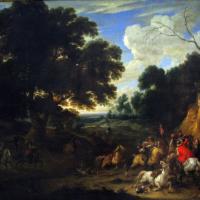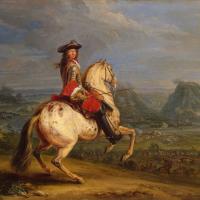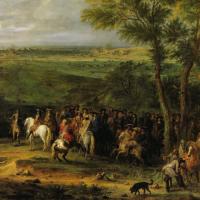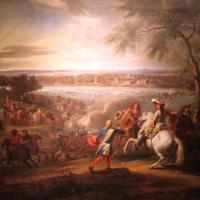Antony Francis Van Der Meulen (1632-1690)
Adam Frans van der Meulen or Adam-François van der Meulen (11 January 1632– 15 October 1690) was a Flemish painter and draughtsman who was particularly known for his scenes of military campaigns and conquests. Snayers also painted portraits, hunting scenes, paintings of chateaux and landscapes. He created designs for prints and cartoons for tapestries.He worked in the service of the French king Louis XIV of France for whom he painted his victories, his new possessions and portraits. He was instrumental in building the propagandistic image of the French king as the 'Sun King'. His battle scenes had an important influence on the development on the genre of military painting in France.
Adam Frans van der Meulen was born in Brussels where he was baptized on 11 January 1632. He was the eldest of the seven children of Pieter van der Meulen and his second wife Maria van Steenwegen. His father was a respected notary. He was registered on 5 March 1651 at the Brussels Guild of Saint Luke as the pupil of Peter Snayers. Snayers was a painter from Antwerp who had moved to Brussels to work for the court. He specialized in pictures of battles, attacks on convoys and civilians and hunting scenes. Van der Meulen became a master of the Guild of Saint Luke in Brussels on 5 March 1651.
Van der Meulen's earliest works dealt with the same subject matter as those of his master Snayers, in particular cavalry skirmishes. He was also known for depicting courtly retinues mounted on their horses. His reputation for this type of scene as well as his skill in the painting of horses reached France. This led to the artist being called to Paris where he entered into the service of Louis XIV on 1 April 1664. Jean-Baptiste Colbert, the powerful surintendant des Bâtiments, Arts et Manufactures (Superintendent of Buildings, Arts and Manufactures) and later minister of finance, is believed to have been behind the royal appointment of van der Meulen. Colbert had been charged with immortalizing the military successes of Louis XIV. To achieve this propagandistic purpose, he had come up with the idea to create a series of tapestries that would show the heroic deeds of the king.
The court painter (Premier peintre du roi) Charles Le Brun had been put in charge of the Gobelins Manufactory, the royal tapestry works newly created in 1663, and was officially appointed its director on 8 March 1663. To realize Colbert's project of a series of tapestries on the king's military campaigns, Le Brun sought to surround himself with a team of painters who would be capable of translating his ideas into tapestries and van der Meulen was recruited to assist Le Brun in this project. Van der Meulen’s varied skills were particularly appreciated for this purpose. Van der Meulen's reputation as a skilled painter of horses has been cited as one of the reasons why he was solicited to work in France.
Van der Meulen was involved in the design of multiple tapestry series. He first worked on the series of The History of the King for which he created the scenes of the military conquests. As the design work involved a lot of work, van der Meulen invited other Flemish artists to assist him with his designs. The landscape artist Adriaen Frans Boudewijns entered in 1666 into a 3-year contract to work in the service of Adam Frans van der Meulen. When van der Meulen worked on the design of 12 Gobelinsrepresenting the months for King Louis XIV, van der Meulen executed the smaller figures and part of the landscapes while the remainder of the landscapes was completed by Boudewijns and Abraham Genoels, another Flemish painter active in Paris. While in Paris, Boudewijns also engraved many of van der Meulen's compositions. Boudewijns married the sister of van der Meulen called Barbe or Barbara on 12 January 1670. From 1668 van der Meulen worked on the series of tapestries called the 'Maisons royales' ('Royal Residences') depicting the various palaces of the king.
Van der Meulen's career in France took off rapidly. His annual wages at the Gobelins Manufactory were regularly increased and he was in 1666 one of its best-paid artists. He accompanied Louis XIV during his campaign through Flanders during the War of Devolution. He made drawings of various cities including Turnhout, Kortrijk, Oudenaarde, Aalst and Lille. His paintings representing the campaigns of Flanders in 1667 so delighted the King that from that date van der Meulen was ordered to accompany him on all his expeditions. He accompanied le Grand Condé during his campaign through Bourgogne-Franche-Comté.
He obtained in 1669 the royal privilege to have his works engraved. He was appointed peintre ordinaire du Roy (ordinary painter to the king) in 1673. In the same year he was received into the Académie royale de peinture et de sculpture (Royal Academy of Painting and Sculpture) without having to submit a reception piece as was usually the case. He attained the grade of councilor in the Academy in 1681 and that of principal councilor in 1688.
Van der Meulen had married Catharine Huseweel before he moved to France. The couple had several children. One son, Louis who was born on 20 March 1669 was baptized on 27 March 1669 in the chapel of the Tuileries by the archbishop of Nazianze and coadjutor of Reims and had King Louis XIV as godfather and Anne Marie Louise d'Orléans, Duchess of Montpensier as godmother. His first wife died in January 1677. On 22 March 1679 he signed a marriage contract with Catherine Lobry, daughter of a captain of the guard of Count Bassigni. She died already on 4 October 1680. He married 20-year-old Marie de Bye, a cousin of Charles Le Brun on 12 January 1681. The couple had many children of whom one was born posthumously.
He painted the designs for the decorations of the Ambassadors Staircase, the grand staircase of the King’s apartment at Versailles (four trompe l'oeil tapestries representing the taking of various towns, 1677). From 1679 he worked on the large-scale paintings of The King’s Conquests (Les conquêtes du Roi) intended for the decoration of the Royal Pavilion of Marly on which he worked until his death in 1690. Marly was a new pleasure residence built for the King as an architectural fantasy, with twelve little pavilions and elegant Royal Pavilion laid out on a square plan. He died in Paris in 1690. After his death, seals were affixed to his apartment and studio, as had been the case at the time of Le Brun's death a short time before, since Louis XIV asserted his royal privilege. As van der Meulen was an ordinary painter to the King, and resided at the Manufacture des Gobelins, the sovereign ordered a number of works to be seized, which he thought proper to be returned to him.





